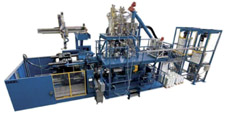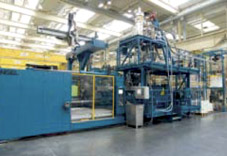
Incorporating fillers and additives broadens the property profile and thus the field of application of plastics. Production of material compounds is a common practice in plastics processing, but for economic reasons is generally limited to situations typified by large quantities and a standard assortment. Demand for special compounds, usually involving custom formulation sand amounts, will grow to the same extent that plastic applications expand into new niches. Compounds with a high percentage of long glass fibers or powdered additives in particular fall into this category. In keeping with this trend, Engel Austria GmbH has developed a system concept that combines a standard injection molding machine and a compounder in a modular manner. Moreover, the standard functions of each module remain fully intact; each can, if necessary, be operated independently of the other. Only the combination melds the two standard machines into an efficient system for special applications.
Universal system concept Molded parts with a high long glass fiber content as well as a filler level as high as 65% of high-density material and a certain ratio of virgin to recycled resin are already appearing in bid specifications from automakers. Solutions to problems associated with special requirements can be found with complex material formulations, especially when it comes to confining engine compartment noise or ensure the stability of structural body components. In most cases, this requires material mixtures that are not available commercially and the composition of which must be optimized as part of the development process. Accordingly, the solution in this case is called inline compounding on the injection molding machine and transfer of the plasticated compound directly into the injection unit of the machine. In spite of the special requirements, Engel誷 own specifications stipulated that the system should not be a single-purpose combination, but rather a universally applicable standard injection molding machine with modular attachments. The starting point for the system concept, which was actually based on a concrete project, was a large Engel Duo 7050/1000 injection molding machine with a 2-platen clamping unit and a clamping force of 10,000 kN. To permit use in more than just general single-material molding, a second injection unit was mounted in a space-saving piggyback position (angled downward) on top of the standard injection unit. In this way, multi-material parts can be produced using commercially available resins, if necessary. However, the opportunities for processing are not supposed to be limited to precompounded resins, but also include the special compounds mentioned at the beginning. Accordingly, the injection unit of the molding machine was coupled to an inline compounder. Within this combination, the melt stream is expected to reach the injection unit via the shortest possible path, so that the compact dimensions make operation and maintenance of the entire system simple. That is what was stipulated in the project specifications. For this reason, the development team chose to place the compounder directly adjacent and parallel to the injection unit of the molding machine.
 Combining a continuous and a cyclical process
Combining a continuous and a cyclical process Equipment components that were close to standard were also to be used in the compounding module. These were designed in collaboration with Leistritz Extrusionstechnik GmbH, Nuremberg, Germany. The starting point here was a co-rotating twin-screw extruder with parallel screws based on a modular arrangement of specific segments that, when combined, formed 50 mm screws(overall length 36D). The extruder is connected to a material conveying and metering station for a total of six components - virgin resin, recycled resin, masterbatch, stabilizers, powdered additives with a high bulk density a
Adidas Incorporating fillers and additives broadens the property profile and thus the field of application of plastics. Production of material compounds is a common practice in plastics processing, but for economic reasons is generally limited to situations typified by large quantities and a standard assortment. Demand for special compounds, usually involving custom formulation sand amounts, will grow to the same extent that plastic applications expand into new niches. Compounds with a high percentage of long glass fibers or powdered additives in particular fall into this category. In keeping with this trend, Engel Austria GmbH has developed a system concept that combines a standard injection molding machine and a compounder in a modular manner. Moreover, the standard functions of each module remain fully intact; each can, if necessary, be operated independently of the other. Only the combination melds the two standard machines into an efficient system for special applications. Universal system concept Molded parts with a high long glass fiber content as well as a filler level as high as 65% of high-density material and a certain ratio of virgin to recycled resin are already appearing in bid specifications from automakers. Solutions to problems associated with special requirements can be found with complex material formulations, especially when it comes to confining engine compartment noise or ensure the stability of structural body components. In most cases, this requires material mixtures that are not available commercially and the composition of which must be optimized as part of the development process. Accordingly, the solution in this case is called inline compounding on the injection molding machine and transfer of the plasticated compound directly into the injection unit of the machine. In spite of the special requirements, Engel誷 own specifications stipulated that the system should not be a single-purpose combination, but rather a universally applicable standard injection molding machine with modular attachments. The starting point for the system concept, which was actually based on a concrete project, was a large Engel Duo 7050/1000 injection molding machine with a 2-platen clamping unit and a clamping force of 10,000 kN. To permit use in more than just general single-material molding, a second injection unit was mounted in a space-saving piggyback position (angled downward) on top of the standard injection unit. In this way, multi-material parts can be produced using commercially available resins, if necessary. However, the opportunities for processing are not supposed to be limited to precompounded resins, but also include the special compounds mentioned at the beginning. Accordingly, the injection unit of the molding machine was coupled to an inline compounder. Within this combination, the melt stream is expected to reach the injection unit via the shortest possible path, so that the compact dimensions make operation and maintenance of the entire system simple. That is what was stipulated in the project specifications. For this reason, the development team chose to place the compounder directly adjacent and parallel to the injection unit of the molding machine.
Incorporating fillers and additives broadens the property profile and thus the field of application of plastics. Production of material compounds is a common practice in plastics processing, but for economic reasons is generally limited to situations typified by large quantities and a standard assortment. Demand for special compounds, usually involving custom formulation sand amounts, will grow to the same extent that plastic applications expand into new niches. Compounds with a high percentage of long glass fibers or powdered additives in particular fall into this category. In keeping with this trend, Engel Austria GmbH has developed a system concept that combines a standard injection molding machine and a compounder in a modular manner. Moreover, the standard functions of each module remain fully intact; each can, if necessary, be operated independently of the other. Only the combination melds the two standard machines into an efficient system for special applications. Universal system concept Molded parts with a high long glass fiber content as well as a filler level as high as 65% of high-density material and a certain ratio of virgin to recycled resin are already appearing in bid specifications from automakers. Solutions to problems associated with special requirements can be found with complex material formulations, especially when it comes to confining engine compartment noise or ensure the stability of structural body components. In most cases, this requires material mixtures that are not available commercially and the composition of which must be optimized as part of the development process. Accordingly, the solution in this case is called inline compounding on the injection molding machine and transfer of the plasticated compound directly into the injection unit of the machine. In spite of the special requirements, Engel誷 own specifications stipulated that the system should not be a single-purpose combination, but rather a universally applicable standard injection molding machine with modular attachments. The starting point for the system concept, which was actually based on a concrete project, was a large Engel Duo 7050/1000 injection molding machine with a 2-platen clamping unit and a clamping force of 10,000 kN. To permit use in more than just general single-material molding, a second injection unit was mounted in a space-saving piggyback position (angled downward) on top of the standard injection unit. In this way, multi-material parts can be produced using commercially available resins, if necessary. However, the opportunities for processing are not supposed to be limited to precompounded resins, but also include the special compounds mentioned at the beginning. Accordingly, the injection unit of the molding machine was coupled to an inline compounder. Within this combination, the melt stream is expected to reach the injection unit via the shortest possible path, so that the compact dimensions make operation and maintenance of the entire system simple. That is what was stipulated in the project specifications. For this reason, the development team chose to place the compounder directly adjacent and parallel to the injection unit of the molding machine.  Combining a continuous and a cyclical process Equipment components that were close to standard were also to be used in the compounding module. These were designed in collaboration with Leistritz Extrusionstechnik GmbH, Nuremberg, Germany. The starting point here was a co-rotating twin-screw extruder with parallel screws based on a modular arrangement of specific segments that, when combined, formed 50 mm screws(overall length 36D). The extruder is connected to a material conveying and metering station for a total of six components - virgin resin, recycled resin, masterbatch, stabilizers, powdered additives with a high bulk density aAdidas
Combining a continuous and a cyclical process Equipment components that were close to standard were also to be used in the compounding module. These were designed in collaboration with Leistritz Extrusionstechnik GmbH, Nuremberg, Germany. The starting point here was a co-rotating twin-screw extruder with parallel screws based on a modular arrangement of specific segments that, when combined, formed 50 mm screws(overall length 36D). The extruder is connected to a material conveying and metering station for a total of six components - virgin resin, recycled resin, masterbatch, stabilizers, powdered additives with a high bulk density aAdidas













